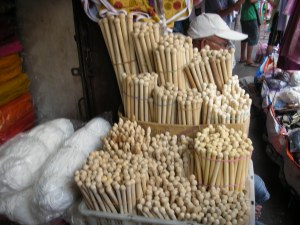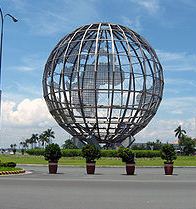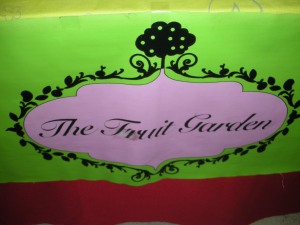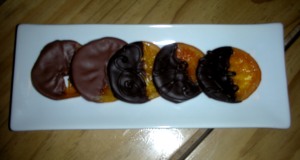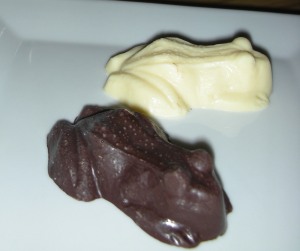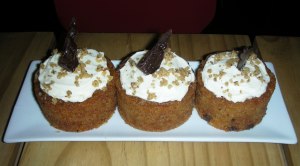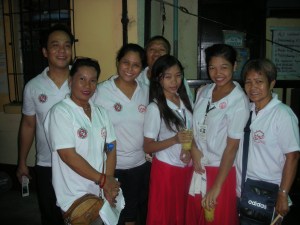Our day started at dawn. We were to meet Chef Bao from the Vietnam Cookery Centre at the Ben Thanh Market in downtown Saigon. Chef Bao proved hard to miss. Dressed in his white chef’s jacket, he was shaped just like the cook in The Magic Pudding: a roly poly puddin’ of a man, the polar opposite of his companion Miss Khanh, our petite and quietly spoken Interpreter and guide.
 Ducking through the crowds, we followed our guides through the market, examining longan and rambutan, jackfruit, dragonfruit, durian and marvella – or gac in Vietnamese which you say in the back of your throat without any vowels, like you’re choking.
Ducking through the crowds, we followed our guides through the market, examining longan and rambutan, jackfruit, dragonfruit, durian and marvella – or gac in Vietnamese which you say in the back of your throat without any vowels, like you’re choking.
We trawled through the seafood where live soft-shell crabs were being packed on a tray like packs of cards. Surprisingly, they don’t run away: apparently they are too weak. However a hefty, blue-pincered crab, despite being tied up with string, was hanging from the side of the basket by one huge claw. I suggested a rescue mission, but the stallholder merely shrugged and went on gutting fish. We inspected an assortment of fish, many still alive and squirming in an inch of water. There were shellfish of all shapes and sizes, and buckets of giant, British-racing-green garden snails.
Then a stall of offal had to be deciphered, as I was not familiar with pig’s womb, its intestines, stomach, or gizzards. And what was this? I asked, pointing. A ball of cooked blood, of course. Good for soup I am told.
Vegetable stalls abounded with green leafy plants such as water spinach and morning glory. There were knobby Lotus roots, hairy Indian taro and gourds called bittermelon that looked like elderly, wrinkled cucumbers. One stall was overflowing with a wide variety of bean curd tofu (dau hu). Another was crammed with small sacks of different-coloured rice, jars of sharks fins and dried sea horses, crystallized ginger and crates of small dried fish. It was like something out of Diagon Alley: myriad stalls brimming with exotic ingredients for Potions classes.
Miss Khanh was finally forced to deflect my barrage of questions and take us to the cooking school.  It seems Chef Bao came in even earlier to buy the ingredients for today’s class, so the shopping was done. A short taxi ride ended down a pot-holed lane at the wide, open doorway of the cooking school, an old-fashioned, wooden structure with a cool, dim interior. There was a distinct lack of the stainless steel we are used to seeing in professional western kitchens. Instead all was polished wood, ceiling fans, pretty blue and white china bowls, clay pots and coconut shell stirring spoons.
It seems Chef Bao came in even earlier to buy the ingredients for today’s class, so the shopping was done. A short taxi ride ended down a pot-holed lane at the wide, open doorway of the cooking school, an old-fashioned, wooden structure with a cool, dim interior. There was a distinct lack of the stainless steel we are used to seeing in professional western kitchens. Instead all was polished wood, ceiling fans, pretty blue and white china bowls, clay pots and coconut shell stirring spoons.
We joined the only other student at the dining table – another Australian – and together we explored a large bowl of favourite Vietnamese spices: cinnamon or cassia sticks, fresh chillies, turmeric, star anise, cardamom, gingko and galangal.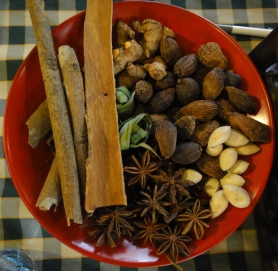 The three of us were then encouraged to don aprons and look at the day’s menu. Chef Bao took his place on the dais and we sat down obediently at our stations as Interpreter Khanh took us through the ingredients we were to use: ingredients which had already been prepared earlier by the kitchen fairies. The tiny bowls were filled with chopped garlic, slices of ginger, fish sauce and Thai basil.
The three of us were then encouraged to don aprons and look at the day’s menu. Chef Bao took his place on the dais and we sat down obediently at our stations as Interpreter Khanh took us through the ingredients we were to use: ingredients which had already been prepared earlier by the kitchen fairies. The tiny bowls were filled with chopped garlic, slices of ginger, fish sauce and Thai basil.
Vietnamese cuisine may not yet be as well-known, globally, as Chinese or Thai, but it is rapidly rising up the charts. Here in South Vietnam the food bears a distinct family resemblance to Thai, with undertones of Chinese, which is hardly surprising after more than one thousand years of colonization, (from approximately 200 B.C. to 1000 A.D.) Stir-frying, egg noodles and Buddhism have made their mark. Buddhism dictated strict vegetarianism, which led to the evolution of many delicious vegetarian dishes designed to tempt the carnivorous locals. In the south, Indian immigrants arrived with the French in the nineteenth century and introduced hotter, spicier dishes than can be found up north. And indeed, freshly chopped red chillies glisten brightly in one of the bowls at our station.
From the French, the Vietnamese took bread, coffee and dairy products which are still very popular here in Saigon, if the number of bakeries and coffee shops around the city are anything to go by. We discovered a special local coffee named ‘Weasel’ because the beans have been eaten and regurgitated by rare Vietnamese weasels. This cycle radically alters the taste of the coffee resulting in a strong, smooth coffee with appealing hints of chicory. The French influence also means that here in the south, sautéing is often preferred to wok stir-frying.
In general, the Vietnamese use oil lightly and heavy sauces are rare. There is a profusion of vegetables, eaten raw or lightly steamed, and an abundance of fresh salads that often include fruit such as pomelo or mango for that popular combination of sweet and sour. And like many South-East Asians, the Vietnamese prefer grazing over a feast of small, shared dishes rather than indulging in individual plates heaped with food as we do.
 So, back in the kitchen we began to create our own Vietnamese feast. Chef Bao started us gently with a yellow soy bean sauce to accompany the fresh spring rolls we would make next; an easy enough exercise to follow the Chef’s instructions step-by-step. The fresh spring rolls proved a little more problematic. Apparently we had to dampen the rice paper first, before folding in the edges and arranging the prawns, pork slices, rice noodles and julienne of egg omelet on top. All of us made the error of using too much water and ended up with a limp, sticky sheet, but we salvaged what we could and learnt a valuable lesson before wrapping a second, and a third. Each ingredient was settled in place like a mosaic on the slightly damp rice paper. I was pleased to be able to adjust the ingredients, as the spring rolls we had eaten in the market earlier had been heavily over-worked with Thai basil, and other more delicate flavours were lost. Our results may not have been perfect, but we were pleased with our efforts nonetheless.
So, back in the kitchen we began to create our own Vietnamese feast. Chef Bao started us gently with a yellow soy bean sauce to accompany the fresh spring rolls we would make next; an easy enough exercise to follow the Chef’s instructions step-by-step. The fresh spring rolls proved a little more problematic. Apparently we had to dampen the rice paper first, before folding in the edges and arranging the prawns, pork slices, rice noodles and julienne of egg omelet on top. All of us made the error of using too much water and ended up with a limp, sticky sheet, but we salvaged what we could and learnt a valuable lesson before wrapping a second, and a third. Each ingredient was settled in place like a mosaic on the slightly damp rice paper. I was pleased to be able to adjust the ingredients, as the spring rolls we had eaten in the market earlier had been heavily over-worked with Thai basil, and other more delicate flavours were lost. Our results may not have been perfect, but we were pleased with our efforts nonetheless.
We then gathered around Chef Bao to watch him prepare the rice, just a little differently from me with my electric rice cooker. The rice was rinsed three times and poured into individual clay pots which were then placed in a huge steamer, a couple of knotted pandan leaves tossed in for extra flavour. We were then asked to produce what I understood was a dish of salty chicken with ginger, until I later examined the recipe book: Miss Khanh was actually saying sautéed chicken!
Ginger was common to all the recipes we were using, so each of us cheerfully adapted the quantity according to our personal tastes. 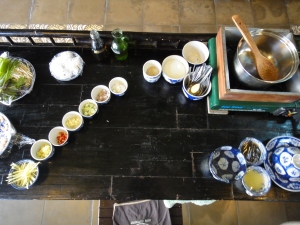 We marinated our chicken in a long list of ingredients, before stir frying it in a small clay pot until fragrant scents began to waft temptingly under our noses. Our final task is to prepare the soup: mustard leaf soup with minced pork. The minced pork gives the stock a light, salty flavour, but I think next time I will strain it out before serving, as it is too inclined to become over-cooked and then the texture becomes rubbery and unappetizing.
We marinated our chicken in a long list of ingredients, before stir frying it in a small clay pot until fragrant scents began to waft temptingly under our noses. Our final task is to prepare the soup: mustard leaf soup with minced pork. The minced pork gives the stock a light, salty flavour, but I think next time I will strain it out before serving, as it is too inclined to become over-cooked and then the texture becomes rubbery and unappetizing.
At last the feast was complete and we carried our various pots to the dining table to test what we had created. Thumbs way, way up for our spring rolls and the chicken dish, and I haven’t eaten such sticky steamed rice in years – the sort that only needs fingers and a good appetite. There was not time for us to make the pudding as well. Too much talking, perhaps? Instead we were given ones the kitchen fairies prepared earlier. Familiar with the moreish rice cakes available in Manila, I was the only one who enjoyed the sticky corn pudding. Admittedly the rice looked a lot like Clag paste, but it was gently flavoured by the sweet corn, and it cleared the palate effectively after all the garlic and spices we had used. I am truly sorry this was one dish prepared beforehand, as I would love to have learned how to make it.
As a grand finale, Miss Khanh had prepared a short presentation. We arranged ourselves before Chef Bao and took it in turns to pose for a formal photograph on the dais as he shook our hands and presented our certificates. Chef Bao beamed at us, obviously delighted with his excellent students. I am very envious of those who are living in Saigon, and who are now contemplating a different class next week. Maybe I could fly back for the day..?
 As you probably know by now, I like moving. So this week I will be vacating http://www.inauspiciousbeginnings.wordpress.com and moving to shegathersnomoss.com
As you probably know by now, I like moving. So this week I will be vacating http://www.inauspiciousbeginnings.wordpress.com and moving to shegathersnomoss.com


